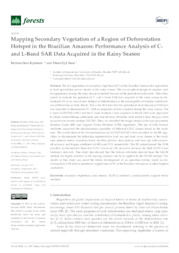Mapping Secondary Vegetation of a Region of Deforestation Hotspot in the Brazilian Amazon: Performance Analysis of C- and L-Band SAR Data Acquired in the Rainy Season.
Mapping Secondary Vegetation of a Region of Deforestation Hotspot in the Brazilian Amazon: Performance Analysis of C- and L-Band SAR Data Acquired in the Rainy Season.
Autoria: KIYOHARA, B. H.; SANO, E. E.
Resumo: Abstract: The re-suppression of secondary vegetation (SV) in the Brazilian Amazon for agriculture or land speculation occurs mostly in the rainy season. The use of optical images to monitor such re-suppression during the rainy season is limited because of the persistent cloud cover. This study aimed to evaluate the potential of C- and L-band SAR data acquired in the rainy season to dis- criminate SV in an area of new hotspot of deforestation in the municipality of Colniza, northwest- ern of Mato Grosso State, Brazil. This is the first time that the potential of dual-frequency SAR data was analyzed to discriminate SV, with an emphasis on data acquired during the rainy season. The L-band ALOS/PALSAR-2 and the C-band Sentinel-1 data acquired in March 2018 were processed to obtain backscattering coefficients and nine textural attributes were derived from the gray level co-occurrence matrix method (GLCM). Then, we classified the images based on the non-parametric Random Forest (RF) and Support Vector Machine (SVM) algorithms. The use of SAR textural attributes improved the discrimination capability of different LULC classes found in the study area. The results showed the best performance of ALOS/PALSAR-2 data classified by the RF algo- rithm to discriminate the following representative land use and land cover classes of the study area: primary forest, secondary forest, shrubby pasture, clean pasture, and bare soil, with an over- all accuracy and Kappa coefficient of 84% and 0.78, respectively. The RF outperformed the SVM classifier to discriminate these five LULC classes in 14% of overall accuracy for both ALOS-2 and Sentinel-1 data sets. This study also showed that the textural attributes derived from the GLCM method are highly sensitive to the moving window size to be applied to the GLCM method. The results of this study can assist the future development of an operation system based on du- al-frequency SAR data to monitor re-suppression of SV in the Brazilian Amazon or in other tropical rainforests.
Ano de publicação: 2022
Tipo de publicação: Artigo de periódico
Unidade: Embrapa Cerrados
Palavras-chave: ALOS-2, Chuva, Sentinel-1, Support vector machines, Vegetação Secundária
Observações
1 - Por padrão são exibidas publicações dos últimos 20 anos. Para encontrar publicações mais antigas, configure o filtro ano de publicação, colocando o ano a partir do qual você deseja encontrar publicações. O filtro está na coluna da esquerda na busca acima.
2 - Para ler algumas publicações da Embrapa (apenas as que estão em formato ePub), é necessário ter, no celular ou computador, um desses softwares gratuitos. Sistemas Android: Google Play Livros; IOS: iBooks; Windows e Linux: software Calibre.
Acesse outras publicações
Acesse a Base de Dados da Pesquisa Agropecuária (BDPA) para consultar o acervo completo das bibliotecas da Embrapa.

